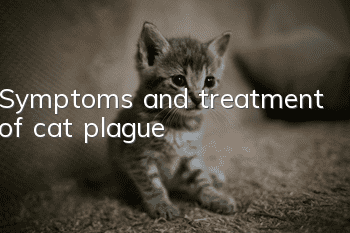Symptoms and treatment of cat plague

What are the epidemic characteristics of cat plague
Feline distemper is also called feline panleukopenia and feline infectious enteritis. This is an acute and highly contagious infectious disease. The incubation period is generally about one week. Susceptible cats mainly include unvaccinated cats, incompletely vaccinated cats, and cats that live in the same room with infected cats.
Popular features
In addition to infecting domestic cats, this virus can also infect other cats (such as tigers and leopards), mustelids (minks) and raccoons of the bear family. Cats of all ages can be infected. In most cases, cats under 1 year old are susceptible, with an infection rate of up to 70% and a mortality rate of 50% to 60%. Kittens under 5 months old have a mortality rate of up to 80% to 90%. As age increases, The incidence rate gradually decreases, and cats raised in groups may have an outbreak in the entire group or the entire litter.
This disease can occur throughout the year, especially in winter and spring.
Infected cats can excrete a large amount of virus from their feces, urine, vomitus and various secretions, and the virus can survive in the environment for a long time.
The long-term detoxification of recovered cats can last for more than 1 year.
Cats in the infected stage can also be spread by blood-sucking insects such as fleas, lice, and flies.
What are the clinical symptoms of cat plague
Feline distemper is a highly contagious infectious disease. The mortality rate of sick cats is extremely high. The disease mainly harms young cats with poor resistance. If a female cat is infected with feline distemper virus during pregnancy, it will cause stillbirth, miscarriage and other phenomena. Therefore, we would like to remind all owners to do a good job in epidemic prevention and hygiene to give cats a good living environment.
Clinical symptoms
The incubation period of feline distemper is 2-9 days, and clinical symptoms are related to age and virus virulence.
Kittens often suffer from acute illness, with body temperature rising above 40°C and vomiting. Many cats do not show any symptoms and die suddenly. Some may show symptoms of spinal ataxia.
Most cats over 6 months old show subacute clinical symptoms. They first have a fever to about 40°C, then drop to normal temperature after 1-2 days, and then rise again after 3-4 days, which is the biphasic fever type.
The sick cat is in low spirits, anorexia, and has intractable vomiting. The vomit is yellow-green, there is sticky secretion in the mouth, eyes, and nose, and the feces is sticky. When diarrhea occurs, it means that the animal is in the late stage of the disease and the feces is bloody. , severe dehydration, anemia, and death in severe cases.
Treatment methods for cat plague
Before treating any disease, a diagnosis must be made first, and misdiagnosis must not be allowed. The diagnosis of feline plague can be based on clinical symptoms and laboratory examination methods. There is also a relatively convenient and fast test paper test method, which can be diagnosed in one minute. NowThey are sold in all major pet hospitals.
Preventive and control measures
Treatment methods can use specific therapy and symptomatic therapy,
Specific therapy
Use feline plague hyperimmune serum or feline monoclonal antibody for intramuscular or subcutaneous injection, 2 ml per kilogram of body weight, usually once every other day. If it is very serious, it can be injected once a day, up to 3 times in a row.
Use feline recombinant interferon, 300,000 to 500,000 units per kilogram of body weight.
Symptomatic treatment
Antiemetic: Food and water should be avoided when vomiting occurs. Metoclopramide injection 0.15~0.25 ml per kilogram of body weight, twice a day, intramuscularly or subcutaneously.
Anti-inflammatory: Gentamicin 10,000 units per kilogram of body weight or kanamycin 50,000 to 100,000 units per kilogram of body weight, twice a day, intramuscularly or subcutaneously.
Antipyretic: Bupleurum injection 0.3 ml per kilogram of body weight, twice a day.
Hemostasis: Vitamin K3 injection 0.3 ml per kilogram of body weight, twice a day, intramuscular injection.
Fluid rehydration: When dehydration or vomiting occurs, mix 5 to 10 ml of 25% glucose, 5 ml of 5% sodium bicarbonate, and 30 to 50 ml of compound normal saline for intravenous injection.
Diet therapy: It is recommended to feed a small amount of easily digestible, low-fiber, low-fat food, 3 to 6 times a day. Prescription foods for acute gastroenteritis disease are also available. Gradually increase the amount of food over several days to meet the animal's needs.
What are the precautions for treating cat plague?
Cats are animals that like to hide their illness. Even though they are seriously ill, they still act like they are doing nothing. Of course, careful owners can still find some clues. When you find that your cat has abnormal behavior, you should seek medical advice as soon as possible to confirm whether it is infected with feline distemper. Early detection will help with treatment and recovery.
Things to note when treating cat plague:
1. Be sure to keep warm.
2. If there are other cats at home, please isolate the sick cat and pay attention to environmental sanitation and disinfection.
3. Feline distemper hyperimmune serum is very important. It is actually an antibody to the feline distemper virus. In the treatment, it is the only one that specifically targets the virus. But be careful not to inject for more than three days in a row, as more may cause side effects. If there is no high-immune serum for local medical conditions, you can find an adult healthy cat that has been vaccinated, draw the blood of the healthy cat, and use a separation method to extract the serum for the sick cat.
4. Fluid rehydration balance and prevention of acidosis
Infusion is the best treatment method. If the cat cannot be given infusion, you can feed it a mixture of 10% glucose injection and normal saline every once in a while to help it replenish energy and water. If you can buy liquid electrolyte for pets,The effect is better.
5. Use antibiotics to prevent secondary infections
Commonly used antibiotics include gentamicin, which is given twice a day and 20,000 units at a time.
A new antibiotic drug for animals is now called Pukansu. You can consult your doctor for specific dosage.
There are also traditional Chinese medicine Qingkailing injections, which also have good results.
6. Antiemetic
Metoclopramide injection is a good antiemetic drug and is very important during treatment. It can be injected or taken orally.
7. Regulate digestive function
Due to the large amount of antibiotics used during treatment, the beneficial flora in the cat’s intestinal digestive tract is disrupted. It is necessary to take large doses of medicines or health care products that regulate the health of intestinal flora; such as lactase, Mommy's Love, probiotics, etc. Such digestive medicines that regulate the intestinal tract should be taken separately from antibiotics at least half an hour apart.
8. Other drugs such as dexamethasone and VC are drugs that help metabolism and can be added depending on the situation.
9. During the recovery period, pay attention to the base protein in the diet (don’t feed milk, eggs, chicken liver, etc. temporarily), and give cats semi-liquid food that is easy to digest. You can buy a nutritional paste for your cat, which will provide more comprehensive nutrition. Or consider purchasing Sears' prescription AD (Asthenia/Acute Disease) Cat Can, which contains minced meat soup that can be fed through a syringe to cats recovering from illness.
The last thing to note is that in the later stages of cat plague, there may be symptoms of blood in the stool. Cats need to be injected with hemostatic injections to prevent it, or take Yunnan Baiyao orally.
- Will adopted stray cats recognize their owners?
- Can blue cats eat raw cabbage?
- Can cats eat stewed pork ribs?
- Can cats eat uncooked chicken?
- Can cats eat preserved egg sausage and meat?
- How can I stop my cat from scratching the sofa?
- Do free-range cats live happier lives?
- Why does a cat have blood in its stool?
- How to treat cat moss quickly
- How to train an American Bobtail cat



